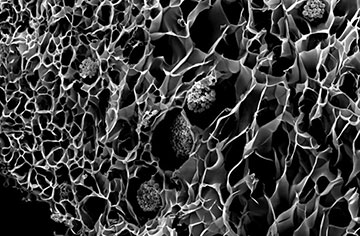![]()
Close-up of coral reef microstructures consisting of a coral skeleton (white) and coral tissue (orange-yellow). [Image: Courtesy of Nature Communications]
Among the many other roles corals play in the oceanic ecosystem, the invertebrates crucially manage the incoming light for the microscopic algae that dwell in their interior spaces. The species live in symbiosis: the tiny plants consume the carbon dioxide and other waste products of their hosts, and in turn the algae provide photosynthetic nutrients—with the coral walls passing just the right amount of light to benefit the dwellers.
Too often these days, stress causes the corals to expel their algal communities—coral bleaching—which can lead to the death of the coral reef and a giant interruption to the reef’s ecology. A multinational research team aims to bring back some of that biodiversity by 3D printing coral-inspired structures that can act as light-mediating incubators for the next generation of microalgae (Nat. Commun., doi: 10.1038/s41467-020-15486-4).
As designed by scientists from the University of Cambridge, U.K., and the Scripps Institution of Oceanography, USA, the artificially printed corals mimic the optical and mechanical properties of real-life invertebrate polyps and can support up to 109 microalgae organisms per milliliter.
“Wonderfully strange creatures”
The study’s lead author, Daniel Wangpraseurt, a marine biologist with joint postdoctoral appointments at Cambridge and Scripps, says he did his Ph.D. thesis on the optical properties of corals in order to understand both their lifecycles and their bleaching. He says he also wondered whether the “light harvesting strategies that corals have evolved over millions of years” could lead to new methods for cultivating microalgal colonies that could be harvested for bioenergy.
“I am very interested in the field of bioinspiration and biomimetics, and there have been some excellent examples of bio-inspired tech that have made it to the market,” Wangpraseurt says. “Corals are such wonderfully strange creatures, I was sure that we would learn a lot from them.”

A scanning electron microscope image of the microalgal colonies in the hybrid living biopolymers. [Image: University of Cambridge]
To design the 3D-printed corals, Wangpraseurt teamed up with Shaochen Chen, a professor of nanoengineering at the University of California, San Diego, USA (the parent institution of Scripps), and Silvia Vignolini, a Cambridge chemist specializing in photonic structures found in nature. They studied corals of the family Pocilloporidae, which have a calcium carbonate skeleton that passes light evenly to the inner algae. Once the photons enter the coral structure, they are refractively trapped inside, enhancing their path length and increasing the chance that algae will absorb the photons.
For the actual printing, the team created a “bio-ink” of hydrogel and cellulose-derived nanocrystals infused with one kind of microalgae that normally live within Pocilloporidae corals. “It took us a while to find the right biomaterials and printing parameters that can support the growth of live algae cells,” Chen says.
Enhancing light with synthetic corals
The synthetic corals contain cylinders about 1 mm long with the same kind of broadband diffuse visible-light scattering that real corals exhibit. To test the light-enhancing properties of the printed synthetic corals, the researchers seeded their printed materials with a different type of algae and monitored the algal growth over multiple days.
According to Wangpraseurt, the experiments involved a variety of scientific disciplines: bioengineering, photonics, coral reef science and marine biology. “Fusing these techniques is a challenge, and effectively communicating with scientists from different fields is an important skill to learn,” he adds. “However, I enjoy this very much as I believe that we can learn a lot from working at the interface of different scientific disciplines.”
Next, the researchers want to learn how to scale up their 3D-bioprinting technique to fabricate larger synthetic colonies, which could lead to biofuel harvesting as well as coral reef restoration.
